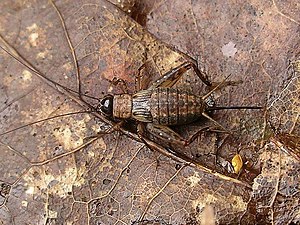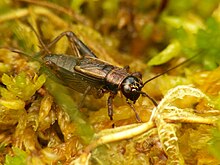Forest cricket
| Forest cricket | ||||||||||||
|---|---|---|---|---|---|---|---|---|---|---|---|---|

Forest cricket, Nemobius sylvestris , female |
||||||||||||
| Systematics | ||||||||||||
|
||||||||||||
| Scientific name | ||||||||||||
| Nemobius sylvestris | ||||||||||||
| ( Bosc , 1792) |
The Forest Grille ( Nemobius sylvestris ) is a Langfühlerschreckenart from the family of crickets . It is the only European species of the genus Nemobius .
features
With a body length of almost one centimeter (in adult animals), the forest cricket is much smaller than the field cricket . It has no hind wings and only short fore wings, which in the male cover half of the abdomen and in the female are reduced to short scales. The forest cricket is unable to fly, but the male uses the wings as a stridulation organ . The body color is mostly dark brown, with the legs and pronotum a little lighter. A striking feature is a pentagon open to the front on the head shield, which is formed from thin, light lines.
distribution
The forest cricket has a relatively limited distribution area in Western and Central Europe and North Africa. It extends from Morocco over the Iberian Peninsula to southwest Poland , the Czech Republic and Slovenia , in Italy it occurs only in the north, in England only in the extreme south. Further to the east there is only a few, sometimes dubious, evidence. In Germany, the forest cricket is widespread and mostly very common, but is absent in the north and northeast.
habitat
This species of cricket lives in the fall foliage of European deciduous forests. Due to overwintering in the larval stage, it absolutely needs the insulating fall foliage layer in severe winters and is not found in areas with mean winter temperatures of well below −1 ° C. Temperatures higher than 25 ° C can only be withstood when the air humidity is higher, since the forest cricket, especially as an adult animal, is very sensitive to dehydration. These habitat requirements explain the preferred settlement of deciduous forests in Atlantic climates.
Reproduction
The male chirps in two different pitches in order to attract the female (loud chirping, spontaneous singing) and to woo her (low chirping, advertising singing). If a female now appears, this is touched with the feelers. If it keeps still, it signals readiness for mating. A female lays around 150 eggs in the upper soil layers. The eggs rest over the winter, the next year the larvae hatch from June to September, and overwinter in the fifth of eight instars. In warmer areas, the development cycle is shortened to one year, in which case the larvae hatch in the year of oviposition. In some areas, both development cycles are possible, so that there is a mixing of the two populations isolated in the two-year cycle. Even large larvae and crickets sometimes overwinter, but the egg-laying next spring is then unsuccessful.
literature
- Helgard Reichholf-Riehm: Insects . Munich 1984

